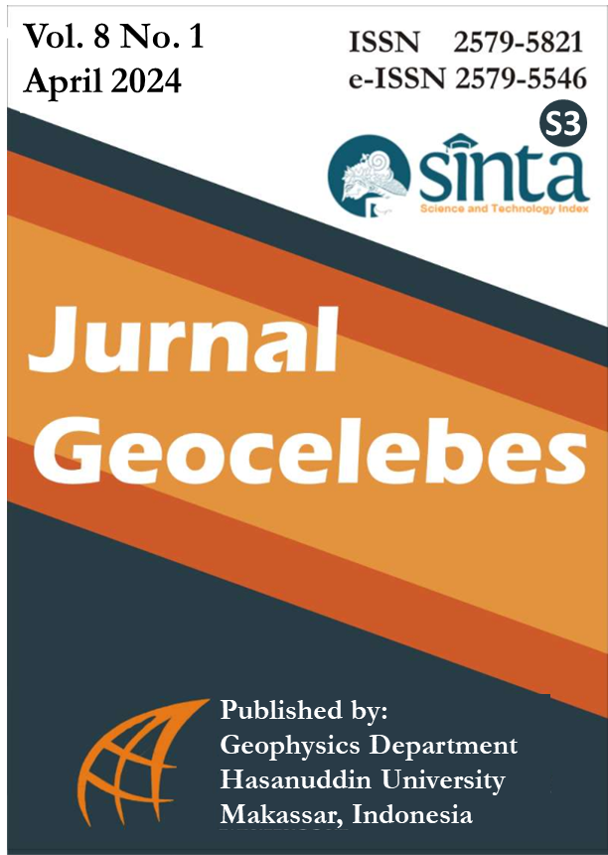Analysis of Ground Vibration Levels Due to the Blasting Process at PT. Bumi Suksesindo
DOI:
https://doi.org/10.20956/geocelebes.v8i1.32853Keywords:
Blasting Ground Vibration, Scaled Distance (SD), Peak Particle Velocity (PPV), Power RegressionAbstract
Ground vibration is one of the effects of the blasting process; when the ground vibration reaches the highest level, it will disturb comfort and even cause damage to the surrounding building structure. This research aims to determine the magnitude of ground vibrations in Pit A and Pit C, as well as determine the relationship between Peak Particle Velocity (PPV) and scaled Distance, and determine the maximum explosive charge weight per delay based on the SNI 7571: 2010 reference. Actual ground vibration measurement data during research based on PPV theory and the actual PPV power regression relationship with scaled distance was used to obtain a ground vibration prediction formula to be a reference for determining the amount of explosive filling per delay. The ground vibration produced in the blasting process is hoped not to exceed the safe threshold. Prediction of the ground vibration formula at 100 m to 1500 m according to the US Bureau of Mines where the Mean Squared Error (MSE) value is 0.54, the MSE value from the Langefors-Kihlstrom equation is 1.85 while the MSE value from the Ambersays-Hendorn equation is 0.31 with the slightest deviation is very good to use as a reference for predicting ground vibrations with the predicted PPV formula. Hence, the maximum explosive charge with a PPV limit of 2 mm/s is 2.452 kg, a PPV limit of 3 mm/s is 11.332 kg, and a PPV limit of 5 mm/s is 23.040 kg. The factors that influence ground vibration are the Distance from the blasting location to the measurement location and the maximum number of explosives per delay, so the results taken from this research are that blasting in Pit A and Pit C is still categorized as safe for infrastructure and community housing.
References
Ambraseys, N. N., & Hendron, A. J. (1968). Dynamic Behaviour of Rock Masses. J. Wiley & Sons.
Amiri, M., Hasanipanah, M., & Amnieh, H. B. (2020). Predicting ground vibration induced by rock blasting using a novel hybrid of neural network and itemset mining. Neural Computing and Applications, 32(18), 14681–14699. https://doi.org/10.1007/s00521-020-04822-w
Bui, X. N., Nguyen, H., Tran, Q. H., Nguyen, D. A., & Bui, H. B. (2021). Predicting Ground Vibrations Due to Mine Blasting Using a Novel Artificial Neural Network-Based Cuckoo Search Optimization. Natural Resources Research, 30(3), 2663–2685. https://doi.org/10.1007/s11053-021-09823-7
Duvall, W. I., & Petkof, B. (1959) Spherical propagation of explosion-generated strain pulses in rock. Washington DC: US Bureau of Mines.
Fadhly, F., Yulhendra, D., & Anaperta, Y. M. (2014). Analisis Ground Vibration pada Kegiatan Peledakan dengan Metoda Peak Particle Velocity Beserta Pengaruhnya Terhadap Bangunan di PT. Pamapersada Nusantara Distrik MTBI Job Site Tanjung Enim. https://www.researchgate.net/publication/283515623_ANALISIS_GROUND_VIBRATION_PADA_KEGIATAN_PELEDAKAN_DENGAN_METODA_PEAK_PARTICLE_VELOCITY_BESERTA_PENGARUHNYA_TERHADAP_BANGUNAN_DI_PT_PAMAPERSADA_NUSANTARA_DISTRIK_MTBU_JOB_SITE_TANJUNG_ENIM
Halimah, H., & Octova, A. (2018). Analisis Ground Vibration Untuk Mendesain Lereng Yang Stabil Pada Penambangan Batu Gamping CV Tekad Jaya Halaban Kabupaten 50 Kota Sumatera Barat. Jurnal Bina Tambang, 3(4), 1784–1792. https://ejournal.unp.ac.id/index.php/mining/article/view/102303/0
Herdy, A. S., Widodo, S., & Nurwaskito, A. (2015). Analisis Pengaruh Powder Factor terhadap Hasil Fragmentasi Peledakan pada PT. Semen Bosowa Maros Provinsi Sulawesi Selatan. Jurnal Geomine, 3(1), 154–158. https://doi.org/10.33536/jg.v3i1.17
Himanshu, V. K., Roy, M. P., Mishra, A. K., Paswan, R. K., Panda, D., & Singh, P. K. (2018). Multivariate statistical analysis approach for prediction of blast-induced ground vibration. Arabian Journal of Geosciences, 11(16), 460. https://doi.org/10.1007/s12517-018-3796-8
Instantel. (2020). 8-Channel Blastmate IIITMand Minimate PlusTMMulti-sensor Vibration and Overpressure Monitors. https://cdn.thomasnet.com/ccp/10019814/103446.pdf
Jalbout, A., & Simser, B. (2014). Rock mechanics tools for mining in high stress ground conditions at Nickel Rim South Mine. Deep Mining 2014: Proceedings of the Seventh International Conference on Deep and High Stress Mining, 189–208. https://doi.org/10.36487/ACG_rep/1410_11_Jalbout
Jianhua, Y., Jiyong, C., Chi, Y., Xiaobo, Z., & Liansheng, L. (2022). Discussion on blasting vibration monitoring for rock damage control in rock slope excavation. Earthquake Engineering and Engineering Vibration, 21, 53–65. https://doi.org/10.1007/s11803-021-2071-2
Kumar, S., & Mishra, A. K. (2020). Reduction of blast-induced ground vibration and utilization of explosive energy using low-density explosives for environmentally sensitive areas. Arabian Journal of Geosciences, 13(14), 655. https://doi.org/10.1007/s12517-020-05645-8
Langefors, U., & Kihlstrom, B. (1963) The modern technique of rock blasting. Wiley.
Ma'rief, A. A., Qadri, A., Okviyani, N., & Mahyuni, E. T. (2020a). Analisis Pengaruh Jumlah Bahan Peledak Terhadap Ground Vibration Akibat Ledakan Pada Area Pit SM-A Tambang Batubara Di PT. Sims Jaya Kaltim Jobsite PT. Kideco Jaya Agung Kabupaten Paser Provinsi Kalimantan Timur. Jurnal Geomine, 7(2), 74–79. https://doi.org/10.33536/jg.v8i1.578
Ma'rief, A. A. F., & Miranda, M. (2020b). Analisis Ground Vibration Akibat Ledakan Pada Tambang Nikel Di PT. Vale Indonesia, Tbk. Jurnal Geocelebes, 4(2), 129–133. https://doi.org/10.20956/geocelebes.v4i2.11084
Moomivand, H., & Vandyousefi, H. (2020). Development of a new empirical fragmentation model using rock mass properties, blasthole parameters, and powder factor. Arabian Journal of Geosciences, 13(22), 1173. https://doi.org/10.1007/s12517-020-06110-2
Nateghi, R. (2012). Evaluation of blast induced ground vibration for minimizing negative effects on surrounding structures. Soil Dynamics and Earthquake Engineering, 43, 133–138. https://doi.org/10.1016/j.soildyn.2012.07.009
Nguyen, H., Drebenstedt, C., Bui, X. N., & Bui, D. T. (2020). Prediction of Blast-Induced Ground Vibration in an Open-Pit Mine by a Novel Hybrid Model Based on Clustering and Artificial Neural Network. Natural Resources Research, 29(2), 691–709. https://doi.org/10.1007/s11053-019-09470-z
Nuñez, A. E. C., Ortiz, C. E. A, & Silva, J. M. (2022). Effect of Dynamic Stress Produced by Rock Blasting on the Optimal Dimensioning of Room and Pillars in Horizontal Layers. Advances in Materials Science and Engineering, 7826557, 1–13. https://doi.org/10.1155/2022/7826557
Putra, S. A. P. (2023). Optimasi Powder Factor Terhadap Fragmentasi Batuan Hasil Peledakan Dan Digging Time Di Pit C Tambang Emas, PT. Bumi Suksesindo, Kab. Banyuwangi, Provinsi Jawa Timur. UPN Veteran.
Rezaeineshat, A., Monjezi, M., Mehrdanesh, A., & Khandelwal, M. (2020). Optimization of blasting design in open pit limestone mines with the aim of reducing ground vibration using robust techniques. Geomechanics and Geophysics for Geo-Energy and Geo-Resources, 6(40), 1–14. https://doi.org/10.1007/s40948-020-00164-y
Roy, M. P., Singh, P. K., Sarim, M., & Shekhawat, L. S. (2016). Blast design and vibration control at an underground metal mine for the safety of surface structures. International Journal of Rock Mechanics and Mining Sciences, 83, 107-115. https://doi.org/10.1016/j.ijrmms.2016.01.003
Roy, P. P. (2021). Emerging trends in drilling and blasting technology: concerns and commitments. Arabian Journal of Geosciences, 14(7), 652. https://doi.org/10.1007/s12517-021-06949-z
Rusmawarni, R., Nurhakim, N., Riswan, R., & Ferdinandus, F. (2017). Evaluasi Isian Bahan Peledak Berdasarkan Ground Vibration Hasil Peledakan Overburden Pada PT Bina Sarana Sukses Kecamatan Sungai Raya Kabupaten Hulu Sungai Selatan Provinsi Kalimantan Selatan. Jurnal Fisika Flux: Jurnal Ilmiah Fisika Fmipa Universitas Lambung Mangkurat, 14(1), 8–13. http://dx.doi.org/10.20527/flux.v14i1.3583
Supratman, S., Anshariah, A., & Bakri, B. (2017). Produktivitas Kinerja Mesin Bor Dalam Pembuatan Lubang Ledak Di Quarry Batugamping B6 Kabupaten Pangkep Propinsi Sulawesi Selatan. Jurnal Geomine, 5(2), 59–62. https://doi.org/10.33536/jg.v5i2.127
Tohirin, T., Wijaya, A. E., & Prastowo, R. (2022). Analisis Getaran Tanah untuk Mengurangi Kerusakan Akibat Peledakan pada Tambang Terbuka. Jurnal Geocelebes, 6(2), 203–211. https://journal.unhas.ac.id/index.php/geocelebes/article/view/19831
Yilmaz, O. (2023). Drilling and blasting designs for parallel hole cut and V-cut method in excavation of underground coal mine galleries. Scientific Reports, 13(1), 2449. https://doi.org/10.1038/s41598-023-29803-6
Yin, Z. Q., Hu, Z. X., Wei, Z. Di, Zhao, G. M., Hai-Feng, M., Zhang, Z., & Feng, R. M. (2018). Assessment of Blasting-Induced Ground Vibration in an Open-Pit Mine under Different Rock Properties. Advances in Civil Engineering, 4603687, 1–10. https://doi.org/10.1155/2018/4603687
Yudha, A. W., Hariyanto, R., Siri, H. T., Gunawan, K., & Siwidiani, I. L. (2022). Kajian Teknis Pengontrolan Ground Vibration Level Pada Operasi Peledakan Bedrock Sorowako East Dan West Area PT Vale Indonesia Tbk, Sorowako Kecamatan Nuha Kabupaten Luwu Timur Provinsi Sulawesi Selatan. Jurnal Teknologi Pertambangan, 8(1), 26–41. https://doi.org/10.31315/jtp.v8i1.9129
Downloads
Published
How to Cite
Issue
Section
License
Authors who publish with this journal agree to the following terms:
- Authors retain copyright and grant the journal right of first publication with the work simultaneously licensed under a Creative Commons Attribution License that allows others to share the work with an acknowledgement of the work's authorship and initial publication in this journal.
- Authors are able to enter into separate, additional contractual arrangements for the non-exclusive distribution of the journal's published version of the work (e.g., post it to an institutional repository or publish it in a book), with an acknowledgement of its initial publication in this journal.
- Authors are permitted and encouraged to post their work online (e.g., in institutional repositories or on their website) prior to and during the submission process, as it can lead to productive exchanges, as well as earlier and greater citation of published work (See The Effect of Open Access).





